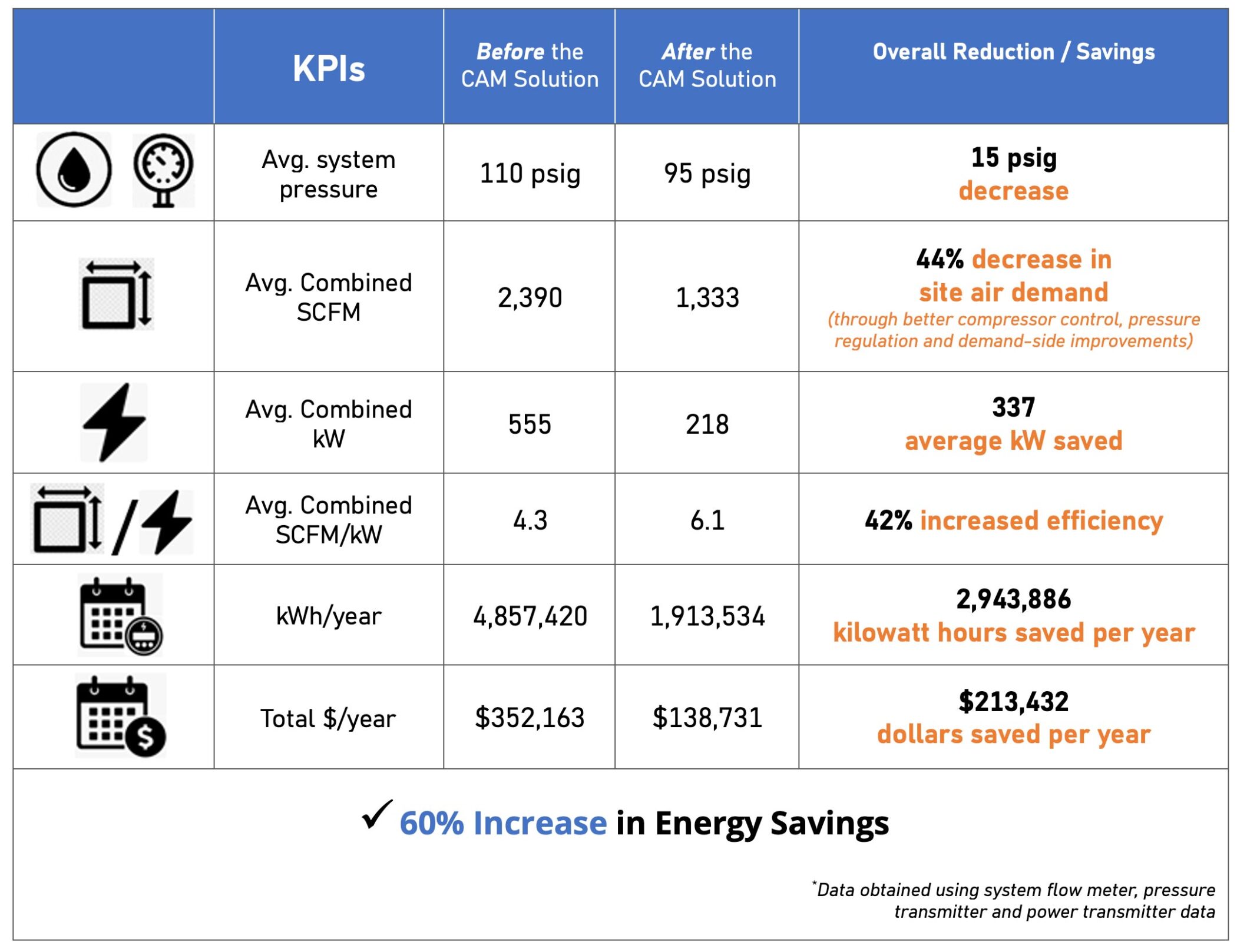Where We Started
An aluminum manufacturer in northwest Ohio – producing aluminum castings for both the automotive and non-automotive industries – reached out to CAM Technologies with a problem. They had five facilities across the country and a heavy reliance on compressed air for a variety of casting processes and solutions.
In one particular facility, the air compressor room was in the back corner of the building with two exterior-facing walls and minimal room ventilation. This positioning created a hot and dusty environment that contributed to frequent issues for the plant, including tripping equipment, low plant air pressure, production loss and wet air; a combination that led to poor air system efficiency and uptime.
The Opportunity
In November 2021, CAM Technologies partnered with an energy performance contracting company to conduct an on-site compressed air assessment at this customer’s facility to identify the opportunities for improvement within the system and showcase efficiency enhancements, cost savings projections and reliability improvements.
At this facility, the compressors within the air system were fighting each other for control. This resulted in frequent unit cycling, multiple part-loaded compressors, and significant amounts of continuous, unloaded horsepower. All compressors were air-cooled and there was poor ventilation in the compressor room. During the summer months, the compressor room would get very hot and often trip out operating equipment. During the winter months, plant operators would have to frequently open and close the compressor room overhead door and manually change the damper position to prevent over-cooling or overheating.
We set out to improve the overall ventilation and system quality for this aluminum manufacturer, but the primary driver for this project was delivering on significant energy savings for them.
Our Solution
CAM Technologies specified and selected equipment to redesign their existing system and proposed a comprehensive, turn-key solution which included:
- A new CAMLink™ Micro System, inclusive of compressor and dryer interfaces for extracting, monitoring, alarming and trending controller data
- A new 3,000-gallon dry receiver tank
- New, no-loss drain traps to replace failed or missing ones
- A new CAMLink™ Demand Expander valve in the main system air header
- Integrated instrumentation including, pressure, dew point, flow, air temperature and ambient air temperature transmitters
- Added side-wall exhaust fans and louvers with thermostatic control for improved compressor room temperature control and ventilation
- On-site electrical and mechanical coordination and installation
- On-site and in-office project management and engineering services
- On-site equipment startup and commissioning services
- Post-commissioning customer training and support
- Our annual CAMLink™ Online service, which includes remote support by CAM engineers, text and email alerts, and a web-based data historian and analytics tool utilized to track system performance, identify system issues in data, and help maintain overall system efficiency long-term.
Their Results
Improved system operating efficiency and pressure stability.
Through the redesign of this facility’s compressed air system, the plant was able to make additional demand-side improvements to reduce overall air system demand. From a pressure standpoint, the Demand Expander valve solution specifically helped the facility to lower their average header pressure by 15 psig and maintain total header pressure within +/- 1 psig of the valve target setpoint regardless of air demand or upstream compressor operation.
We originally estimated that their improved operating efficiency coupled with better pressure stability would provide their facility with approximately $120,000 per year in continuous energy savings. However, they surpassed that estimation, ultimately yielding more than $200,000 in savings per year.
Improved system equipment reliability.
The addition of a new ventilation system equipped their facility with a temperature-controlled air compressor room to help prevent frequent equipment trips and interruptions that had been negatively impacting production.
The improved air quality also helped minimize air quality-related component failures that had been recurring in the plant’s original air distribution system.
Improved system awareness and performance.
Included with their new CAMLink™ Micro system was a full year of CAMLink™ Online. This allowed them to display and trend in real time all data points from their system and all connected equipment. Equipment maintenance alerts and custom alarm features for system components allowed for increased system awareness and activity and gave the plant the KPI data needed to make continuous improvements over time. This enabled the site operations team to focus on other critical items within the plant.
Why The CAM Approach?
Our single-source procurement method and assessment to turn-key approach enabled the project team to execute the project within budget, ahead of schedule and delivering substantial results.
